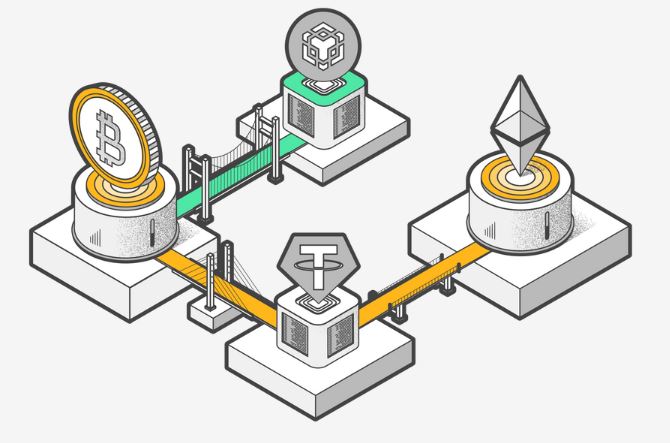Imagine a bustling marketplace where vendors from isolated villages can finally trade their wares. This is the transformative potential of cross-chain transactions in the realm of blockchain technology. Until now, individual blockchains have operated like walled gardens, each with its own currency and protocols. This fragmentation limits the true power of this revolutionary technology. But cross-chain transactions act as the missing bridges, fostering a more interconnected and dynamic digital ecosystem.

Why We Need Cross-Chain Transactions: Breaking Free from Silos
Blockchains are the secure ledgers that power cryptocurrencies and a wide range of groundbreaking applications. They hold immense promise for revolutionizing industries like finance, supply chain management, and identity verification. However, the current state of isolated blockchains creates a fragmented landscape. A Bitcoin can’t be directly used to purchase an NFT on the Ethereum network. This not only limits user experience but also hinders the overall growth and innovation within the blockchain space.
Unlocking a Universe of Possibilities: The Power of Cross-Chain
Cross-chain transactions are the game-changers. They enable the seamless transfer of digital assets, like cryptocurrencies and NFTs, across different blockchains. This opens a door to a universe of possibilities:
- Borderless Transactions: Imagine sending money to a friend abroad using your preferred cryptocurrency, regardless of the blockchain it resides on. Cross-chain transactions remove the need for cumbersome conversions and intermediaries, streamlining global financial interactions.
- The DeFi Boom: Decentralized Finance (DeFi) allows individuals to participate in financial activities without traditional banks. With cross-chain capabilities, DeFi platforms can access a broader spectrum of assets, fostering greater competition and potentially unlocking novel financial products and services.
- A Multi-Chain World: Different blockchains cater to various needs. Some prioritize security, while others focus on speed or low transaction fees. Cross-chain transactions empower users to leverage the strengths of each network. You could store your prized NFT on a highly secure blockchain for ultimate protection while trading it on a faster, cost-effective network for easier transactions.
- The Dawn of the “Interchain”: Imagine a future where all blockchains are interconnected, enabling the free flow of data and value. Cross-chain transactions are the building blocks of this “interchain,” fostering a collaborative environment that fuels innovation and unlocks the full potential of blockchain technology.
Bridging the Gap: How Cross-Chain Transactions Work
The magic of cross-chain transactions lies in the ingenious protocols that facilitate communication between disparate blockchains. Two main approaches pave the way for seamless asset transfer:
- Atomic Swaps: Imagine two people bartering baseball cards on a street corner. An atomic swap operates similarly. Two parties directly exchange digital assets across blockchains without a central authority. The transaction only succeeds if both parties fulfill their obligations, ensuring a secure and trust-minimized exchange.
- Blockchain Bridges: Think of a majestic bridge connecting two islands. Blockchain bridges function as intermediaries, locking assets on one chain and issuing an equivalent representation on the other. Once the transaction is complete, the locked assets are released, and the bridge tokens are destroyed to maintain a balance within the system.

Challenges and the Road Ahead
While cross-chain technology presents a revolutionary future, there are hurdles to navigate:
- Security Concerns: The intricate dance between multiple blockchains introduces potential security vulnerabilities. Developers are constantly working on fortifying protocols to mitigate these risks.
- Scalability Issues: As the volume of cross-chain transactions increases, the system could become overwhelmed. Finding ways to scale these bridges efficiently is crucial for ensuring smooth operation.
- Standardization Hurdles: The lack of a universal standard for communication between blockchains can lead to compatibility issues. Collaboration between blockchain developers is essential to establish common protocols and foster a truly interoperable ecosystem.
A Future Full of Promise: The Evolution of Cross-Chain Transactions
Despite these challenges, the future of cross-chain transactions is bright. As the technology matures, we can expect:
- Enhanced Security and Scalability: Developers are actively researching and implementing solutions to make cross-chain transactions more secure and scalable, paving the way for smoother and more reliable operations.
- Standardized Communication Protocols: Industry-wide collaboration will lead to the establishment of common standards, fostering seamless communication and interoperability between blockchains.
- A New Era of Innovation: With the walls between blockchains crumbling, developers will have the freedom to create groundbreaking applications that leverage the strengths of multiple networks, ushering in a new era of innovation within the blockchain space
Conclusion
In conclusion, cross-chain transactions are a game-changer for blockchain technology. They enable different blockchain networks to communicate and interact, creating a more interconnected and versatile ecosystem. By enhancing interoperability, liquidity, efficiency, and flexibility, cross-chain transactions are paving the way for the future of blockchain technology. As we continue to explore and develop this exciting field, the possibilities for innovation and growth are endless.


